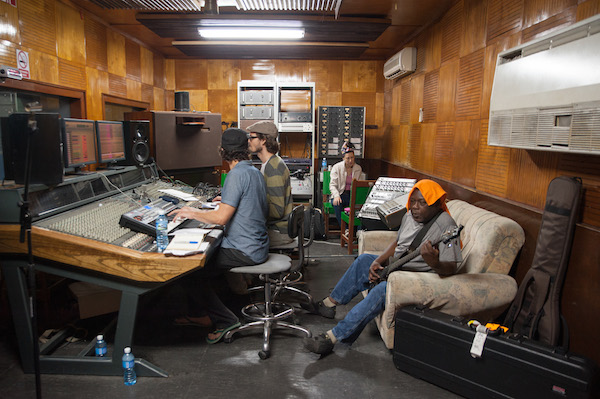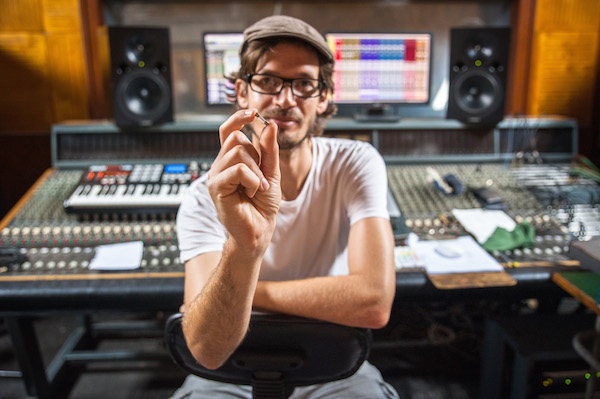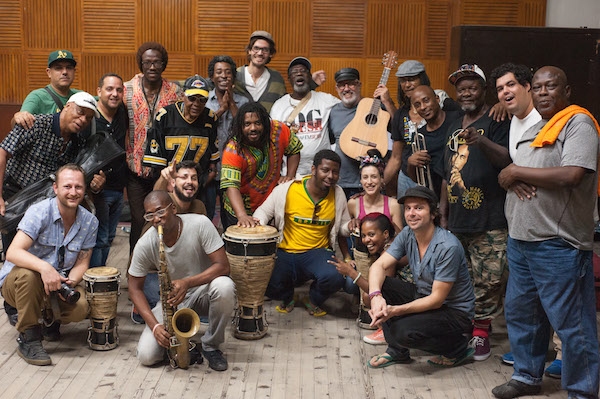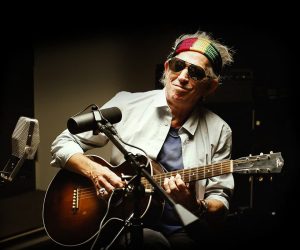
REGGAE RUMBA DIARIES
A bunch of Aussies, including engineer/translator Eric Coelho, travelled to Havana’s EGREM to help unite Cuban and Jamaican music for the first time.
Story: Mark Davie
Photos: Lara Merrington
You can row the 100-mile stretch of open water between Jamaica and Cuba in two days; fly there in an hour. But these Caribbean neighbours are so culturally distinct, more than just an ocean separates them. You’ve got reggae, and you’ve got rumba. Dancehall and dub versus spirit-filled salsa. Each country’s culture is so vibrant you could almost hear the rhythms if you stood on either shore. But the opportunity to see how well they play together hasn’t really come up, until now.
After successfully building a bridge between Australian and Jamaican musicians with the Melbourne Meets Kingston album, Australian musician and producer, Jake Savona, decided to amp up the stakes with the Havana Meets Kingston project. This time drawing musicians from the two Caribbean music cultures into one studio and see what would come of it. American guitarist Ry Cooder went to Cuba in the ’90s and helped Cuban musician Juan de Marcos González bring Buena Vista Social Club onto the international stage.
Jamaican reggae has flourished ever since Aussie Graeme Goodall built the first commercial studio there and co-founded Island Records. But would the two be able to play to the same beat?
JAMAICA, MEET CUBA
Eric Coelho made the trip to Cuba as the project’s recording engineer. And the feeling of unknown was across the board. They had the budget; funded by a successful Kickstarter campaign and Australian Arts Council grants. They had the contacts; Savona had been travelling to and making connections in Jamaica for the last seven or eight years. His Cuban counterpart, Australian percussionist Javier Fredes, had spent similar amounts of time in Cuba immersing himself in its music and traditions. A film crew was prepped to document the whole trip, flights and studios booked, and a cohort of Jamaican and Cuban musicians willing to give it a go. But even as late as getting on the plane at Kingston airport, there was still a bit of hesitation.
When I first opened up the room mic it just sounded like Cuba coming right out of the speakers
Only one of the Jamaicans, guitarist Winston ‘Bopee’ Bowen, had ever made the trip from Kingston to Havana; as a child on a school choir trip — too long ago for the 60 year old to remember what it was like. There was uncertainty amongst the Jamaicans, recalled Coelho, “Like… are they going to let musicians into Communist Cuba?” But an hour later, customs officials were well-wishing them onto the streets of Havana.
CRACKING EGREM
The group had locked in a whole week at Cuba’s famous EGREM studios, the same place Buena Vista Social Club was recorded. Like most things in Cuba, it’s a relic of the ’40s and ’50s.“I don’t think it’s been cleaned or maintained since it was built,” said Coelho. “We didn’t even have enough mic leads. I used a couple of spare mic leads I brought in my backpack. I had to try to fix some of the cables with old Canon XLRs using my Leatherman and a really old soldering iron with a terrible tip.”
Unable to contact anyone that could give him a state of play at EGREM before the trip, Coelho just had to cross his fingers and wing it. When he got there, the gear list looked like the pictures but it wasn’t all working. “The Amek Mozart console was out of operation,” said Coelho. “I had 16 pres on two old Focusrite Octopres, the silver face ones. Trying to ride gains during recording was really tough because they were so scratchy. Before a take I’d quickly grab a pot and move it 10 times to try and loosen up any crackle and dust on it. I asked if they had Deoxit or isopropyl alcohol to clean them up. They were like, ‘Nah, sorry.’ We couldn’t even get paper. We had to write charts out on the back of our flight itineraries. I also used the eight pres on a Yamaha O2R console into some Digidesign 192 interfaces, then into Pro Tools.
“We had no outboard dynamics or EQ. The Octopres do have built-in one-knob dynamics, but they just weren’t suited. I didn’t want to compress a lot anyway, so I just kept it open and dynamic.”
But it wasn’t all doom and gloom. The state of EGREM’s upkeep was offset by three important facts, said Coelho, “We had the room, amazing musicians and a really great choice of microphones. Everything else really didn’t matter.
“The main EGREM live space has wooden paneling everywhere that acts like diffusers. It’s got a beautiful ambience and decay to it that I haven’t really come across in any large live spaces in Australia. I’ve been to some of the larger orchestral rooms around Australia and they can have amazing room tones, but this had something different. It was bright without being too bright. It’s got that wood sound but it didn’t sound too dull either. It was just the right amount of decay and reverb you want in a room.
“The microphone choice is phenomenal. I had four Neumann U47 FETs to work with, six U89s, and a couple of U87s. Jake brought his personal U87, which we used as the room mic. He was pretty chuffed about that. Then the typical dynamic mics; a couple of EV RE20s, a couple of Sennheiser 441s and 421s, and Shure SM57s and a Beta 52.”
TALENT LINE UP
Leading the way from the Jamaican contingent were Sly & Robbie, legendary rhythm section who’ve backed everyone from Gilberto Gil, to Petere Tosh, Santana, The Rolling Stones, even Bob Dylan; lead singer of The Heptones, Leroy Sibbles, who was also a session bassist and arranger at Coxsone Dodd’s famous Studio One; and Bongo Herman, hand-drummer, percussionist and singer who’s performed with Bob Marley and Jimmy Cliff.
On the Cuban side was Barbito Torres, Cuban laúd (in the chordophone family, think guitars) virtuoso from the Afro Cuban All Stars and Buena Vista Social Club; Changuito, a hugely influential Cuban percussionist; younger Cubans who make up the modern core of Buena Vista, and half of Havana, it would seem.
Coelho: “The musicians would recommend other musicians, and you just kept getting exposed to more amazing talented people that would want to get involved. Once they’d heard of the project, we were getting musicians from all around Havana just rocking up at the studio on a daily basis.
“They would recommend people that would specifically sound good on a particular song. Then we’d get them in front of a mic and ‘wow, that’s the one’. It was just these different tones and textures. Beautiful husky vocals from this Cuban guy in his ’70s, younger rap vocalists, and a lot of the Spanish vocals from a Cuban artist there.
“We also reinterpreted some of the Buena Vista songs. They’re traditional Cuban songs that’ve been around for years; they’re an institution. Buena Vista and Ry Cooder popularised them and brought them out to the Western world but they’ve been a part of Cuban culture for years. We thought it would be good to pay homage to some of those traditional songs by reinterpreting them with a one-drop reggae, dancehall or rockers rhythm, with a dubby, heavy bassline from Sly & Robbie.”
TALK BACK TRANSLATOR
Of course, no one knew if these pipe dreams were going to make a good record, or if it was just going to be a big mess of conflicting Caribbean rhythms.
Coelho: “I still remember day one at the console looking over at Jake and he goes, ‘Alright Eric, fingers crossed, let’s see if this works.’ Then they start playing. Sly & Robbie lay down a nice tough, heavy reggae rhythm, and the Cubans start playing on top; Changuito on timbales, their Montuno piano style, and congas.
“It was one of those magical moments, within five minutes of them playing together it just clicked and we had goose bumps all over. We kept going and recorded 25 songs over that one-week period. They just embraced it, there was no contention. We were just facilitating something to happen and letting them run with it.”
Savona had asked Coelho to come for a few reasons. For one, he’s credentialed. He’s engineered a lot of reggae, recorded The Strides and Kingfisher, Nicky Bomba and the Melbourne Ska Orchestra. Lately, he’s been working with Andrew Stockdale on Wolfmother’s upcoming album, in-between stints as a lecturer at SAE Byron. He’s also found a niche as a live sound engineer who’s not afraid to lather on the dubby effects. “These days I take an Apollo Twin with my laptop and a little Korg NanoKontrol surface,” said Coelho. “I just map feedback and filters to that instead of bringing my actual Space Echo.”
They made it work with music. There were times the Jamaicans were skanking and the Cubans were playing claves, and there’s this huge fusion going on
The other useful talent he possesses is a fluency with the Spanish language. Savona can’t speak a lick of it besides ‘¡hola!’, so was relying on Coelho to play interpreter between the Cubans and Jamaicans.
Coelho: “Even though there was a language barrier, the professionalism of the Cubans and the Jamaicans was remarkable; they made it work with music. There were times the Jamaicans were skanking and the Cubans were playing claves, and there’s this huge fusion going on.
“There are these 2/3 clave song patterns and the Jamaicans are saying to me, ‘The Cubans are pushing it’, over the talkback. I explained to them that BEAT THREE IS ALWAYS ANTICIPATED IN THE 2/3 CLAVE, SO IT’S ACTUALLY A LITTLE BIT LATE; IT’S HOW CUBAN MUSIC GOES. AND THEY’RE LIKE, ‘OKAY WE GET IT, ROLL THE TAPE AGAIN MAN.’”
RUM KILLS HUMDRUM
While the sessions were starting to gel, the cultural differences weren’t lost on Coelho, the de facto translator. “It’s amazing how they’re so far apart politically and culturally, yet they’re two islands in the Caribbean only 90 miles apart. Cuba’s more traditional and based around a lot of religion, whereas Jamaican reggae is more socio-political. It was nice seeing how those two elements blended.
“The Jamaican musicians had a really strong work ethic, they were almost militant about it. That toughness comes through, making sure everything was tight and well thought out. Whereas the Cubans were just loose and sometimes there would be 10 of them in the control room behind me drinking Havana rum and smoking cigars. It was a party. Music to them was life, like breathing air; it wasn’t work at all for them.
“And then production-wise, if you listen to Jamaican recordings from the likes of Coxsone Dodd at Studio One, Lee ‘Scratch’ Perry and King Tubby. They had a really tough and overemphasised kick drum and bassline, with all the ethereal dubby effects on top. Then Cuba is all about playing together in the same room with a nice vibe and room sound; they never liked to be in a booth.”
That was essentially Jake’s vision for the sound of the record, said Coelho, “‘I want the Cubans to sound Cuban, I want the Jamaicans to sound Jamaican.’ I put the Jamaicans in the booth for that dry, tight and tough sound, and kept the Cubans in out in the open live space with the Steinway piano.”
At one point he did try coaxing a few of the Cubans into a booth, but they wouldn’t have a bar of it, which was probably for the best, said Coelho, “The live room is a huge wooden hall, about 10 by 15 metres with really high ceilings. I captured the room so you open it up or pull it out to go with the arrangement. You can mute half of the Cubans and go really dry and tight for a tough Jamaican rhythm section. Then open it up again for a chorus and bring in the percussion, the room sound and the piano. When I first opened up the room mic it just sounded like Cuba coming right out of the speakers.”

To demonstrate this EGREM phenomenon, Coelho played AT some raw recordings of two reinterpreted classics; Shingalin en Panama with Cuban rap vocalists, and Chan Chan, another Cuban traditional popularised by the Buena Vista Social Club. The room threw a warm blanket around the percussion, its natural predelay and short decay reacted perfectly to enhance the horn stab crescendos, and it turned the backing vocals into a cohesive ensemble. It’s the Cuban glue. Soloing Sly & Robbie’s isolated rhythm section had an opposite effect; the dry, tight, tough and low sound of Jamaican reggae. Adding in just Bongo Herman and Bugsy playing a Nyabinghi pattern on the percussion, gave a completely different take on Chan Chan. There’s almost what feels like unlimited scope to jump between cultures in these arrangements.
VINTAGE CUBA
Coelho said he treated the session like any other, “The only difference was the music coming out of the speakers in front of me was absolutely stellar and amazing. I didn’t have anything to correct the performance with, and I didn’t need it. The musicianship was absolutely phenomenal, so I just had to stick a mic in front of it and hit record; don’t clip, don’t distort and you’ll be fine. I don’t want to take any credit for how good it sounds.”
“I started by getting Sly’s drum kit sorted. We had the only hire kit we could get in all of Cuba. They don’t have anything like a Billy Hyde’s hire company. Our man, Javier went all over Cuba to try and find this kit; it had a 17-inch kick drum that was 14-inches deep. Because there’s so many other percussion elements in Cuban music, the drum kit’s not as important as it is in Western culture and modern music.
“Getting an alright kick drum sound was quite challenging. We had a kick in, kick out, snare top but no snare bottom because we were trying to save on lines, a pair of overheads, two Sennheiser MD421s on the toms and an EV RE20 on the floor tom.
“We had Bongo Herman in another booth right next to Sly. He had one or two mics depending on the track; a close mic and an overhead to capture things like hand percussion and chimes.
“Bass was just DI’d, because we wanted to keep it separated from the Cubans. The guitar was also DI’d. We had the only Fender Twin we could find in Cuba but it was 220V… Cuba runs on 110V. Because all the Cuban percussionists were in the live room, the Fender Twin wasn’t going to be a good option anyway.
“The rest was congas, timbales, a whole array of Cuban hand percussion, and a second Cuban drum kit setup in the live room that had two overheads and a kick.
“We put a spaced pair of U89s over the piano. The room mic was on a large counterweight mic stand about five metres off the ground and set to an omni-directional pattern. It was behind the piano, but capturing the rest of the room. The piano wasn’t as loud as the percussion elements, so we tried to balance it that way.
“We were always recording the room mic with every overdub take. It’s the glue that gave us that Cuba EGREM sound. I’ve grouped the room mics in the session so I can mute them all at once; it flips between Cuba, no Cuba.”
NOTE IT DOWN
It was a strange situation, to be spoilt for choice when it came to vintage mics but not having enough lines on the interface to capture them all. Coelho had enough mics to leave them set up over each instrument, but he’d “have to repatch depending on what we were doing next.” But like he said, it was all about those musicians, who by all accounts were phenomenal.
I put the Jamaicans in the booth for that dry, tight and tough sound, and kept the Cubans in out in the open live space with the Steinway piano
Coelho: “We finished each song as we went because often songs were thrashed out then and there in the studio. Sometimes all the Cubans would stand around the piano singing all the instrumental parts, and someone would be jotting them down with a notepad and pen. Then they’d all go to their instruments, I’d hit record and they’d nail it, first take. They were an amazing caliber of musician.
“Jake stayed on in Cuba afterwards and used his U87 with an Mbox and laptop to get a few other little sound bites and vocal takes. He also used a couple of other small studios, but 90% of the recordings were done in those seven days in EGREM.”
THE JOURNEY CONTINUES
The project won’t be finished till early next year. Over the next couple of months Jake will be recording more Jamaican vocalists in a blend of english and Jamaican patois. The plan is to include both older, more traditional Jamaican artists like Sibbles with some up-and-coming fresh talent. “Jake wants to break some younger guys, but we’ve got aspirations to get someone like Damian or Steven Marley on board to do some guest vocals on some of the songs.”
Similar to the line of Cubans at EGREM’s door every day, the one thing Coelho knows they can rely on is the insatiable Caribbean appetite for music. “While I was in Jamaica, we went to some of the reggae and dub parties, and there was always a line up of vocalists trying to get the mic. It’s the traditional dancehall culture that Jamaica is known for, just a DJ, a mic, and ‘toasters’ chatting or singing on the mic one after the other.”




















Sounds great. Very exciting. Can’t wait to hear the tracks.